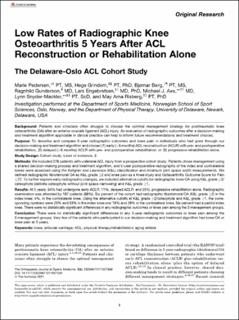Low rates of radiographic knee osteoarthritis 5 years after ACL reconstruction or rehabilitation alone: The Delaware-Oslo ACL cohort study
Pedersen, Marie; Grindem, Hege; Berg, Bjørnar; Gunderson, Ragnhild; Engebretsen, Lars; Axe, Michael J.; Snyder-Mackler, Lynn; Risberg, May Arna
Peer reviewed, Journal article
Published version
Permanent lenke
https://hdl.handle.net/11250/2833820Utgivelsesdato
2021Metadata
Vis full innførselSamlinger
- Artikler / Articles [2119]
Originalversjon
Orthopaedic Journal of Sports Medicine. 2021, 9(8), Artikkel 23259671211027530. 10.1177/23259671211027530Sammendrag
Background: Patients and clinicians often struggle to choose the optimal management strategy for posttraumatic knee osteoarthritis (OA) after an anterior cruciate ligament (ACL) injury. An evaluation of radiographic outcomes after a decision-making and treatment algorithm applicable in clinical practice can help to inform future recommendations and treatment choices.
Purpose: To describe and compare 5-year radiographic outcomes and knee pain in individuals who had gone through our decision-making and treatment algorithm and chosen (1) early (<6months) ACL reconstruction (ACLR) with pre- and postoperative rehabilitation, (2) delayed (>6 months) ACLR with pre- and postoperative rehabilitation, or (3) progressive rehabilitation alone.
Study Design: Cohort study; Level of evidence, 2.
Methods: We included 276 patients with unilateral ACL injury from a prospective cohort study. Patients chose management using a shared decision-making process and treatment algorithm, and 5-year postoperative radiographs of the index and contralateral knees were assessed using the Kellgren and Lawrence (K&L) classification and minimum joint space width measurements. We defined radiographic tibiofemoral OA as K&L grade ≥2 and knee pain as a Knee injury and Osteoarthritis Outcome Score for Pain ≤72. To further explore early radiographic changes, we included alternative cutoffs for radiographic knee OA using K&L grade ≥2/osteophyte (definite osteophyte without joint space narrowing) and K&L grade ≥1.
Results: At 5 years, 64% had undergone early ACLR; 11%, delayed ACLR; and 25%, progressive rehabilitation alone. Radiographic examination was attended by 187 patients (68%). Six percent of the cohort had radiographic tibiofemoral OA (K&L grade ≥2) in the index knee; 4%, in the contralateral knee. Using the alternative cutoffs at K&L grade ≥2/osteophyte and K&L grade ≥1, the corresponding numbers were 20% and 33% in the index knee and 18% and 29% in the contralateral knee. Six percent had a painful index knee. There were no statistically significant differences in any radiographic outcomes or knee pain among the 3 management groups.
Conclusion: There were no statistically significant differences in any 5-year radiographic outcomes or knee pain among the 3 management groups. Very few of the patients who participated in our decision-making and treatment algorithm had knee OA or knee pain at 5 years.
Beskrivelse
This open-access article is published and distributed under the Creative Commons Attribution - NonCommercial - No Derivatives License (https://creativecommons.org/licenses/by-nc-nd/4.0/), which permits the noncommercial use, distribution, and reproduction of the article in any medium, provided the original author and source are credited. You may not alter, transform, or build upon this article without the permission of the Author(s).
